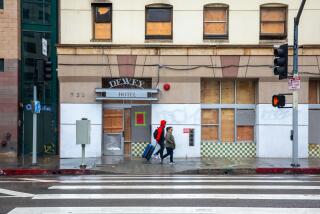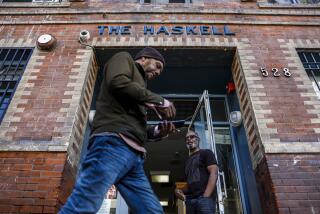Editorial: L.A.’s streets have become a de facto toilet. We need more public restrooms
Perhaps the most humiliating thing about being homeless is having to use the street as your bathroom because you don’t have access to a toilet. The results are grossly unpleasant as well for all who must walk down city sidewalks, pungent with the smell of urine, and step over human feces.
For those on skid row, however, that’s a daily reality. A study conducted early this year by a group of service providers, homeless advocates and residents of skid row found that about 1,800 unsheltered homeless people living there shared a grand total of nine working toilets at night — about the same number of bathrooms that you’d find in a Hollywood Hills estate. They were all located at the Midnight Mission shelter, which opens its bathrooms at night to anyone who needs them. The homeless population has since grown to 2,000.
The number of accessible bathrooms increases during the day to as many as 43, depending on the hour, including portable toilets at two parks and facilities at service providers’ offices. But so does the number of people who need them. The daytime homeless population in the area, which has the largest concentration of homeless people in the city, swells to an estimated 4,600, according to the most recent count.
It’s not as simple as planting a bunch of port-a-potties on skid row sidewalks.
By way of comparison, the United Nations High Commissioner for Refugees’ standard for refugee camps is one toilet for every 20 people. Just meeting that minimal humanitarian threshold would require the city to make 100 toilets available at night in skid row — 11 times the current number — and 230 during the day.
City officials don’t deny that this is a public health crisis and that more toilets are needed. L.A. Mayor Eric Garcetti has earmarked $1.4 million in the current budget for skid row toilets and maintenance.
However, it’s not as simple as planting a bunch of port-a-potties on skid row sidewalks. For one thing, the toilets have to be kept clean (the study found that many of the ones in skid row were filthy). Toilets on dark street corners in skid row at night also can be targets for predators. Yet when security guards are present, they may scare away the people who want to use them. The five automated, supposedly self-cleaning toilets the city installed downtown haven’t been a reliable solution either, breaking down often because people abuse them, stuffing objects, even clothing, into them.
City officials say they would like to contract with more shelters to open their bathroom doors 24 hours a day. And they say they are committed to increasing the number of portable toilets and the number of daily cleanings that toilets are getting.
That’s all well and good, but the city needs to tackle this problem with more urgency (and not just in downtown L.A.). If it’s safest to set up portable toilets in a parking lot with security guards, then the city should be persuading private property owners downtown to open up their lots at night for city-funded and secured portable toilets.
Advocates and city officials envision little clusters of public toilets with hand-washing facilities and service kiosks staffed around the clock by people who provide both security and counseling about homelessness services. That sounds fine, but the price for using a bathroom shouldn’t be a mandatory session with an outreach worker.
The study calls for 100 new portable toilets in the skid row area immediately. City officials say, instead, to give them 60 days to put up 10 more toilets. Ok, let’s start there. We’ll check back in two months. Homelessness is a complex problem, but installing public toilets shouldn’t be. And the need has grown with the homeless population, which ballooned by 20% from 2016 to 2017. So here’s the situation: Either the city puts up a lot more public toilets and maintains them more assiduously, or it leaves the streets to serve as de facto toilets and keeps sending out sanitation crews in hazmat suits to power-wash them.
Follow the Opinion section on Twitter @latimesopinion or Facebook
More to Read
A cure for the common opinion
Get thought-provoking perspectives with our weekly newsletter.
You may occasionally receive promotional content from the Los Angeles Times.






